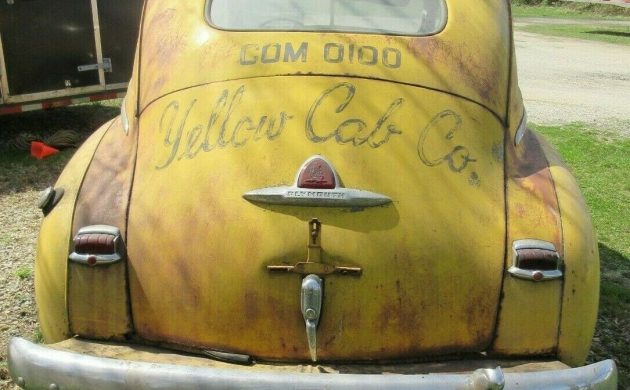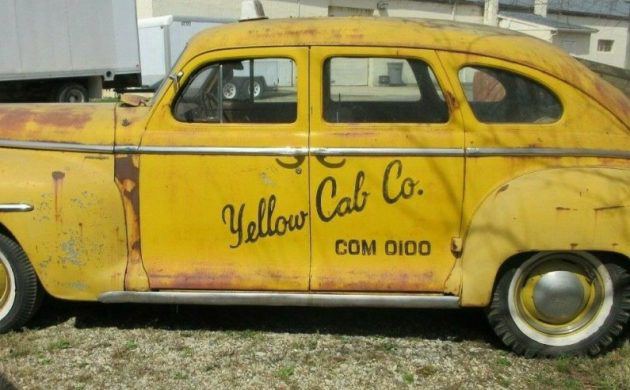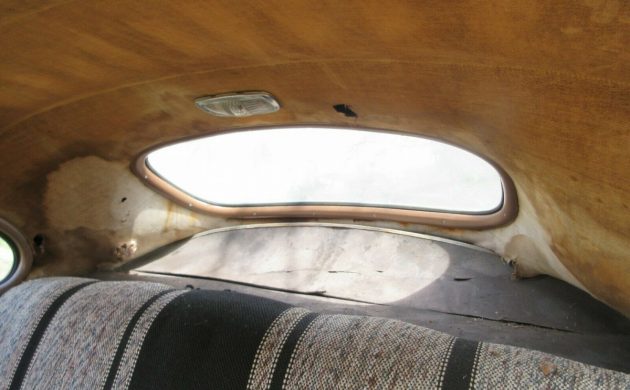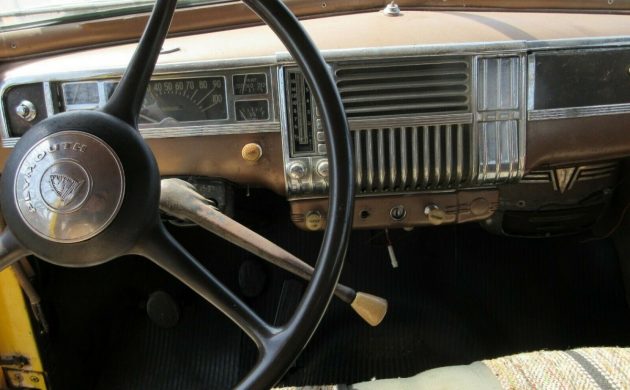Back in 1947, if you wanted a taxi, you stood out by the road and flagged one down. Or called Yellow Cab and they sent one to you. Today, you pull up an App on your phone, and – viola – a rideshare machine shows up (and it likely won’t be painted yellow). Plymouth was a popular car after World War II for taxicab duty and this long-retired example was someone’s daily living. It’s said to run but wouldn’t it be cool restored to its days as a hack? Located in Voorhees, New Jersey, this ’47 Plymouth is available here on eBay where the Buy It Now Price is $5,995 (or you can click the Make Offer button).
The De Luxe and Special De Luxe were full-sized automobiles produced by Plymouth during the 1933-42 and 1946-50 model years. After the war, the De Luxe became the entry-level model, while the Special De Luxe was the top dog. Both cars used a 218 cubic inch inline-six that produced 95 hp that was paired with a 3-on-the-tree manual transmission. The post-war cars, including the seller’s 1947, were largely carryovers from before the war. Plymouth built 382,290 automobiles in ’47, of which nearly a third were De Luxe 4-door sedans, like the seller’s, at 120,757 units.
This car no doubt entered taxicab service when it was new and didn’t go into private duty after it retired. It’s still wearing what’s left of its yellow paint and markings when it was part of the Yellow Cab fleet. The cab’s title reflects two prior owners plus the parties selling the car now. We’re told it’s been in dry storage for years and the interior may have been used as a hideout by mice. Everything about the car speaks “original” so the interior is going to need a complete makeover.
As you might suspect, the car has rust in places we can see (which leads to places that’s we can’t see). The rocker panels and floorboards have been afflicted and there is surface rust on most exterior panels. These 1940s 4-door cars had “suicide doors” which both opened out together. The glass is good except for one pane that may have caught a BB shot. We’re told the car is mostly complete, but until you start taking things apart to fix them, you really won’t know for sure.
Surprisingly, the old taxi runs and drives, but it does not stop. And the tires are ancient, so this is a car not to take past your property lines. The transmission is said to shift smoothly through all the gears, including reverse. But everything here is 74 years old, so chances are some refreshing of the drivetrain must go on the to-do list.
The seller provides a video which is a slide show of 100 photos of the automobile. Hagerty and NADA differ greatly on what this car could be worth. But if I were to take this project on, I’d want it to look just like a 1947 Plymouth Yellow Cab once again, because that would make it an even more rare sight.








I agree on keeping the cab theme going Russ. Cool rig. I wonder if the second owner drove for Yellow also? Otherwise I am surprised it was not painted over at some time.
Yeah it’s quite a surprise this car has survived. Has to keep that look, maybe a modern Hemi for drivability but keep that yellow cab alive.
Curious. Why would you want to put a hemi in it? To go fast, burn rubber or what? Some upgrades would be good, like brakes, but to go hemi or some big block V-8 would destroy its worth. It was a simple car from a much simpler time. Keep it that way.
Exactly. Put the bottle of testosterone down and walk away. A hemi would ruin the experience. Leave it 6 volt so you can hear the vibrator in the radio, which is also curious because taxicabs of the day didn’t use radios. I’m also not seeing holes in the dash where the meters mounted.
I remember my father having one parked down by the barn. It was black, I think. I was only like 5 years old, and was completely fascinated by the center brake light on the trunk. Not only was it glass, but had the Plymouth logo ship stamped into it.
Very cool cars. Huge! And I love suicide doors.
I had a ’46 as a young man and loved it.
Bought it for $50 in the spring of ’74. It
didn’t take me long to get it running and
driving either. My buddies and I would
pile into it for a well rounded night of
fun and insanity whenever I wasn’t playing music on the road. Wound up
selling it to a friend of mine after the
gigs started coming in hot and heavy
and I didn’t have time to work on it. And
yes, I still regret it to this day. Have to
say that I’d restore it as a vintage cab
and put it back to work hauling folks
around Winter Haven. Hey Mike, I
finally got the picture of the ’54 taxi done and it looks really nice too.
Sounds great Ken! Can you email me a copy?
I wonder how many miles this old car has seen? Maybe a million or more. Very cool project if continues the taxi theme. My dad had a 48 Dodge 4 door sedan in green. Good memories.
God bless America
I remember these all around San Fransisco in the ’40’s. That phone number is curious, “COM 0100” has military base connotations, which, I believe would explain the lack of typical taxicab light fixtures, and the big trunk lid advertising dish. There could be a good story here.
Let dog be your guide.
Wouldn’t COM = 266 on the phone dial? Just like Pennsylvania 6-5000 is 736-5000? Or is COM just for military? Could this have been used as a non-number if not an original Yellow Cab? I don’t see any dash between the COM 0100. So, specific use or fake cab?
I have both taillamp lenses for this car, and am willing to part with them. Make on offer.
My Grandparents had a Desoto from around that year when I was a kid. Loved the suicide back doors, those were the first I’d ever seen. The other was it had some torque convertor type clutch in it. Grandpa could put it in first gear and sit there idling with the clutch out and it wouldn’t move till he accelerated the engine. Fascinated me as a kid.
Some 2CVs had that too – it’s called the trafficlutch there. There’s a centrifugal element that doesn’t engage until the revs rise.
Viola? Voila, non?
It was called Fluid Drive. All Chrysler products except Plymouth used it.
I think this is cool but to make it mechanical you will still be at another $3K-$4K minimum and then who knows. There is the interior.
$6K for a static display at the moment for a 40’s Plymouth wearing yellow paint that could have been applied as early as 30 years ago on a lowly sedan seems kinda steep.
I don’t see a reason for someone to store a wore out taxi to begin with
This car gives me nightmares. My dad had one of similar vintage and I and a neighbor boy were playing in the trunk. I had my hand on the hinge and when he shut the trunk, it took off the end of my left middle finger. I still have the short finger to remember the car with!
“We drove in around for over an hour with no issues other than it has no brakes.. peddle goes to the floor.” That’s why a spin around the block ended up taking an hour to get the car stopped.
Could the vintage ‘phone number be from a different country perhaps?
Kenn, I’ll take a crack at your question. The phone number is call for some skepticism. Pretty sure this is a (film) prop. A fake. All of the lettering is perfectly evenly faded. The roof sign is 1970s-1980s. Some of the rust looks faked. Enhanced. The olde-tyme phone number is phony. What you have here is a $500. rusted out 1946-1948 Plymouth 4 door. For some reason, the seller thinks the romance of this having once been a taxi makes it worth $6,000. Huh? Look at HMN, Mecum, etc. You can buy a nice running 1947 Plymouth that looks good inside and out for the same $6,000. This is one of the most common post-WWII cars ever produced. Would be interesting to know what this prop was used for. May have more value then.
Sure can Mike. I have many others too.
I can make just about any vehicle print
with help from Google from brassmobiles to modern cars. But to me, the older cars have much more
appeal than the bland boring crap that
they try to pass off as cars today.
yellow and checker cabs
I am very suspect that this was actually a taxicab. The telltale sign is the roof light is not period correct. Taxicabs of this period typically did not sport whitewalls. The fire wall is not yellow, indicating a respray. Most likely used in a 60’s or 70’s film and parked in a barn.
Dunno, the yellow paint is wearing down to the red primer with no other colors between them. The lettering appears professional; most shake-and-bake movie cars typically have more slapdash lettering, b/c they’re only seen from mid-distance and farther. However, it has a radio (unusual for a cab), the Taxi light appears off-center and year-incorrect, and there is no identifying number on the body (e.g., “Cab 123”).
There is a car number 1296 on the cowl. 2-way radios were used in the 40’s (and even 30’s). The electronics filled the trunk. Due to its excessive cost it would’ve been removed and re-used when the cab was retired just as 2-way radios are removed from retired cabs and police cars today. Same would go for the meter. Not sure when/if the factory supplied yellow fleet vehicles. The taxi companies may have had to have them resprayed when new.
Bang on Joe. This is obviously a (film) prop. Another variation I’ve seen faked for the same 1946-1948 Plymouth / Dodge / Desoto is dressed as a Police car — black body with white doors. Perhaps the seller knows this, or maybe he doesn’t, and has been fooled himself. Aside from the telltale signs you list, the trunk shows that this car was repainted. City phone numbers from late 1950s started with 2 letters, followed by 5 numbers. If this had been a real cab, it would have been decommissioned circa late 1950s. After that, it would have likely been sold and operated as a used car, and not retained Cab paint scheme. It is 2021. Are we to believe that this car has been sitting stored for more than 60 years. Doesn’t pass the sniff test.
My Dad has this exact same car. It’s a solid car that doesn’t have the rust issues that this one has. It was black until sometime in the early 90s he had us paint it yellow and turn it into a taxi. If we could get $6,000.00 for it I think it would be gone!
The cab may have had a different home.
Pa, Va and Mass are commonwealths. The com may have stood for “COMmonwealth”. It would come out (xxx) 266-0100. Also, I think phone numbers were issued sequentionaly, and “100” would be an early number.
I live in western Pa, think there may have been a “commonwealth” exchange.
Anyone with a 266 start on the phone help?
No one has mentioned ANOTHER possiblity, the car may never have been a taxi… but a “movie car taxi”. My uncle used to rent various cars in his collection to movie makers that wanted period cars in their films. This car may have been a regular sedan until one of the owners decided to rent it as a movie taxi. Thus the stuff that would not be correct like radio etc.
Ahhhhhhh…so many are so gullible. This car is nowhere near an original. That paint and lettering were applied much more recently than the 1940’s, lol. This is, at best, a movie car. This guy is trying to cash in on what is nothing more than a roached-out car with little to no value, even if it was in nice shape. Looking at the comments here, P.T. Barnum was wrong…there was actually a sucker born every second.
And here it is again.
https://carscoms.com/1947-plymouth-deluxe-suicide-door-yellow-taxi-cab-444797.html
Interesting “sleuthing” by some of the commentators. It does look like it might have been a prop car. Anyone who’s been on a movie set will know what the prop and effects dept’s can do (I saw downtown Cleveland “destroyed” for Avengers). However, a few other comments need perspective. Not all cabs started out as production fleet vehicles. Many were bought off the lot, either new or used, as standard cars and driven as cabs. Personally owned cabs usually had more creature comforts, like a radio, than company owned cars. Some are retired police or government cars picked up at auction which was my personal experience as a driver. Also, in smaller centres the cab companies often operated on a zone system for fares instead of a meter and radios were not that common before the 60’s. Meters and radios were very expensive. If you wanted a cab, you went to a taxi stand. They didn’t necessarily come to your door.